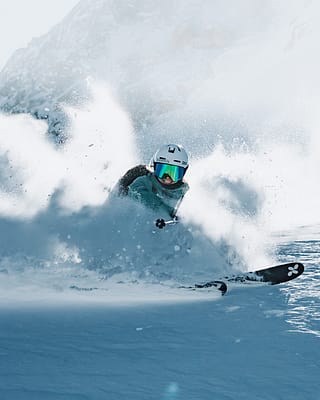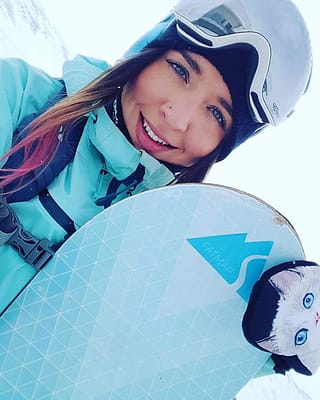How to ski powder
Have you ever found yourself curious about how to ski powder, but wondered where to start? Then be sure to read this article. It's all the need-to-know basics from what powder skiing actually is, to tips and mistakes to avoid.

Skiing is a truly incredible sport. There is no better feeling of accomplishment than achieving something new in skiing. If you feel you have begun to build your skills, nail technique and now you're ready for the next thing, keep reading. Have you ever found yourself wondering how to ski powder as skiers hop between mounds of the fluffy stuff under the chairlift? Perhaps as you passed overhead thinking, "Wow, that looks fun!" If so, then this article will give you all the need-to-know powder skiing basics.
Essential gear for powder skiing
No matter if you're an experienced powder glider or just starting out on your powder skiing journey, one thing's for certain: having the right gear sets the stage for a memorable ride. Your choice of attire not only ensures warmth and comfort but also injects an element of style into your mountain escapades. Paramount among these outfit essentials are high-quality ski pants for men and stylish ladies ski trousers, quintessential elements that guarantee your look is as sleek as your skiing. Don't miss out on these wardrobe must-haves for your powder skiing adventure this season.
What is powder skiing?

If skiing hasn't got you hooked already, then powder skiing surely will. And if you are already in love with skiing, well, powder skiing will ensure you dedicate your life to the sport. Powder skiing simply refers to skiing in lighter, fluffy snow as opposed to on groomed runs. It's an almost totally different sensation to skiing on hard-packed snow or on the marked slopes. It requires a different technique and set of skills which, luckily for everyone, are easy to pick up through practice. The learning process of gaining confidence in powder skiing, we can assure you, is just as fun as being a pro!
Powder skiing generally takes place away from the slopes...
Slackcountry: Popularised Canadian slang for "easy-to-reach backcountry". This tends to be the off-piste area just beyond the boundaries, fences and marked resort areas.
Backcountry skiing: This is skiing away from the main resort and slopes on unmarked or unpatrolled areas inside or outside a ski resort's boundaries. This is essentially the opposite of alpine skiing, which is on groomed trails and is patrolled and regulated.
Off-piste skiing: This is done on unprepared, trackless areas away from regular ski runs.
However, the definitions of the locations where we powder ski have morphed. They are on a spectrum of a little away from the slope to in the middle of nowhere. Starting with off-piste areas and slackcountry, all the way to the backcountry.
The top 5 powder skiing tips

We have put together 5 powder skiing tips to get you started. These tips are easy to remember and are just the thing you need to feel comfortable starting your powder skiing adventure.
Make sure you have the right kit
It all begins with the right kit! A master is only as good as his tools, right? The same applies to powder skiing. We could talk about so much equipment, but the basic things have to be the skis and the outwear.
The skis - Powder skis tend to be broader and longer than piste skis. Powder skis range from around 110mm up to 140mm in waist width, and for a good reason — more surface area. In addition, most powder skis utilise a camber profile that improves float in powder, such as rocker/raised tip and tail, or even reverse camber. This means the tip and tail are higher than the contact point, forming a sort of dished shape, which helps float and manoeuvre in the powder.
The outerwear- If you know you will be riding lots of powder on your next trip, it's worth investing in high-quality outerwear. For powder riding, you want high levels of waterproofing and breathability. This is because powder snow can stick to your jacket and seep into the fibres, making you cold and wet. Opt for taped seams for extra protection. Plus, powder skiing is hard work — you're likely to work up a sweat which is why jackets and pants with breathability will help regulate your temperature, wick away moisture and keep you dry and cosy.
Steering and turning
In powder skiing, you don't use the edge of the ski for grip. Instead, try to steer with your feet and legs. Instead of engaging your edges or creating big angles, guide your skis in the direction you want. It’ll feel a lot ‘looser’ and more like surfing than skiing. But you’ll get the hang of it in no time.
Balance
It can be hard to keep the rhythm in deep powder, especially if you don't feel relaxed. Try pumping your legs up and down when you turn. This will allow you the momentum to remain on the top of the snow, and is even better if you add a little bounce. It may feel odd, but the more you reinforce this movement, the better your balance will be.
Choose your crew
The people you choose to ride powder with are important. You want to be selective where possible. Firstly and most importantly, you ride with good friends or family that are excited. Powder skiing is the most fun, and you want to keep the energy high and the mood to be happy and positive. Plus, if you can endeavour to ride with people who are a little more advanced, they'll be able to push you and your skills to grow.
Speed is your friend
Speed is absolutely your friend. If the powder is deep, slowing down will have you getting caught, the weight of the snow dragging you down until you lose speed. Then, you'll find yourself trying to haul yourself out of heavy snow. Whereas being light on your feet and speedy will allow you to simply float along the top of the powder.
5 common mistakes when skiing powder

Now for the common mistakes to avoid when powder skiing. Of course, the most important thing is not to take it all too seriously and have fun. But let's still check out what you need to be aware of.
Leaning backwards
The natural urge is to lean back. Indeed, one must lean back to keep your tips up and float? But leaning back too much will cause you to lose balance by applying too much force to the tail of your skis, making them squirrely and tough to control. So instead, stand centred over your skis and relax into a skier's stance, shins slightly flexed and a slight bend at your knees, ankles, and hips.
Over-rotating the upper body
If you find your torso facing across the mountain after the turn, then you're probably over-rotating your upper body. Instead, project your body downhill while centred so your skis don't over-rotate. Strengthen your core muscles to counterbalance this problem.
Feet too wide apart
A wide stance will create more drag on the outside ski and might cause you to get stuck into the snow rather than being able to pop and float above it. Keep your feet close together, old school style.
Tails in the snow
Surely if we try to keep our tips up, then our tails must be down? Sure enough, you should try to float and keep your skis above the snow where possible, but instead of pressing down on the tail, try bouncing into a jump turn.
Skiing too slowly
Speed is your friend. As we mentioned, being too slow and cautious will have you sinking beneath the pack and struggling to get going again; stay relaxed, loose and get some speed going. It's the best feeling in the world.

FAQs
Is powder skiing suitable for beginners?
Absolutely! Beginners can indeed take on powder skiing, but it's recommended to have a basic understanding of regular skiing first. As you progress and become more comfortable on your skis, you can start venturing into lighter, fluffy snow to experience the thrill of powder skiing.
What safety measures should I keep in mind while powder skiing?
Proper preparation and safety measures are essential for a successful powder skiing experience. Always ski with a partner, especially in unfamiliar areas. Be mindful of the terrain and potential avalanche risk. It's crucial to carry essential safety equipment, including a transceiver, shovel, and probe, and know how to use them in case of emergencies.
Wrapping up
That's it for the moment; a quickfire article packed with the powder skiing basics. Nothing beats it. So get out there and explore! Armed with the suitable kit and the right crew, it's the best way to ski. Be sure to brush up on more details as you learn, get to know the off-piste equipment and the rules of the mountain. But for now, try little patches between the pistes and play around! It is what it's all about.
Related Reading:










